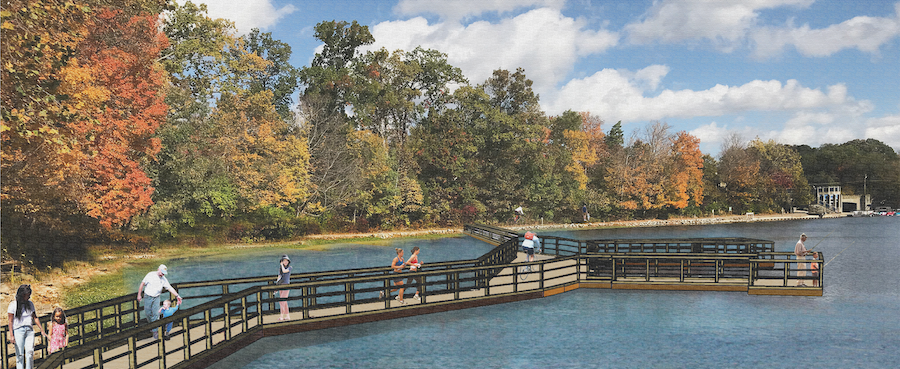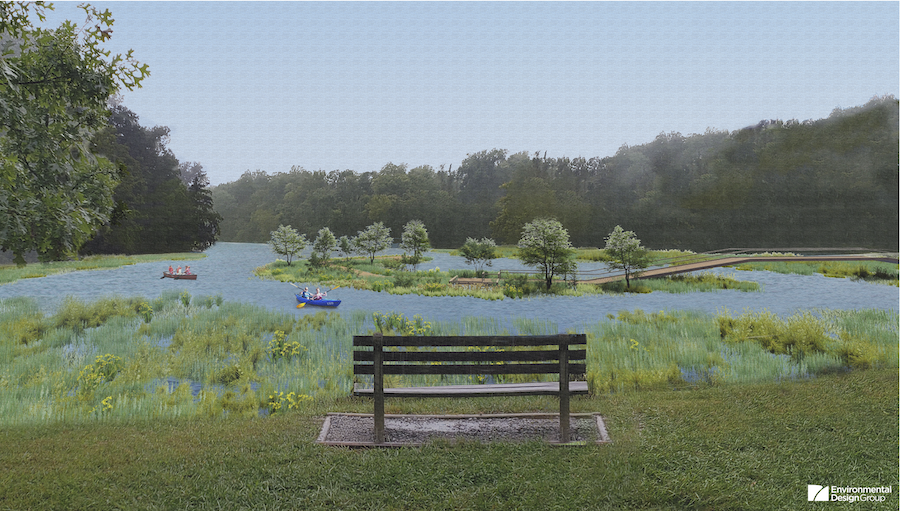About the Project


In 2017, Great Parks began planning for a major, multi-year initiative to renew and improve Sharon Lake as a recreational resource and preserve its beauty as a breathtaking conservation area. With extensive planning nearing completion, Great Parks will drain the water from the 35-acre lake this spring/summer, before repositioning a buildup of soil and silt in the lake to double the existing wetland areas. When complete, the project will improve recreation activities and access to natural areas on and around the lake.
Finding of No Significant Impact – Environmental Assessment
Timelapse Video of Lake Draining
Project Scope & Impact
The project is anticipated to take 18 months to complete. During that time, several areas in the park will be closed for the safety of our guests.
CLOSED beginning April 1, 2024:
- Sharon Lake, including the fishing dock and canoe/kayak launch
- Boathouse
- Shared-Use Trail around the lake – see map of Alternative Trail
- Lakeside Lodge reservable shelter and adjacent parking lot on Kemper Road
The snack bar and harbor playground area are scheduled to remain open during construction.
Visit the Alerts & Closures page for park updates and closures throughout the project.
Tentative Project Timeline
| Activity | Date |
|---|---|
| Permitting and draining preparation | Winter/Spring 2024 |
| Lake draining begins | Spring/Summer 2024 |
| Construction underway | Summer/Fall 2024 - Summer/Fall 2025 |
| Lake to reopen | Late Fall 2025 |
Timeline is an estimation based on the current project status and may vary as construction begins.
Cost & Funding
With design, permitting, surveys, pollution prevention, water management, construction, dredging, transport, restoration, and reopening phases, this improvement project is anticipated to cost more than $11 million.
A special thanks to the Greater Cincinnati Foundation, Dorothy B. Francis Charitable Foundation, Duke Energy Foundation, Land & Water Conservation Fund and State of Ohio Capital Improvement Funding for their support of this project thus far.
Remaining funds will be provided by Great Parks through the current capital project budget as well as additional grants and other funding sources.
FAQs
Can we observe the work?
Yes, there will be an observation point at the harbor.
Why is Great Parks dredging Sharon Lake now?
Sediment accumulation, excess nutrients, and aggressive aquatic vegetation, especially during summers, have reached the point of threatening recreational opportunities and some aquatic habitats.
What will happen to fish in the lake?
The focus of this project is on improving the long-term health of Sharon Lake. In its current condition, the quality of the lake creates poor conditions for fish. While we anticipate some loss of fish life during the draining process, many fish are expected to exit downstream as the lake drains. Some will be left behind and taken by either birds or other predators. Great Parks sought to reduce the number of fish in the lake by working with ODNR to eliminate creel (fishing) limits over a year ago. ODNR does not recommend moving fish between bodies of water. When the lake is refilled, Great Parks will implement a fish restocking program.
What will happen to other animals in the lake?
Some, including turtles and birds, are expected to simply move to other nearby habitats.
Why can’t Great Parks move the fish and other wildlife?
Most fish cannot be moved to other waterways due to state regulations that aim to protect fish from the spread of disease. Catching and moving fish and other wildlife is not guaranteed to be successful and can be cost-prohibitive.
What will the lakebed be like without its water?
The lakebed will dry over many months until the silt at the bottom can be accessed and moved with heavy equipment. Contractors will use lime, a commonly used soil stabilization substance, so that the soil can be worked with more easily. We are notifying neighbors and guests that for a period of time, there will likely be an odor from the decomposing organic material on the exposed lakebed.
Where will Great Parks put the soil?
The soil and silt from the bottom of the lake will be repositioned to preselected areas around the edge of the lake, eventually doubling the lake’s wetland area.
Why didn’t Great Parks take action to prevent dredging from being necessary?
The collection of silt at the bottom of a manmade lake is a natural process in the lifespan of a reservoir. It is accelerated in Sharon Lake due to dense development in the watershed that is outside park district ownership. Sharon Lake has previously been dredged since it was built by the U.S. Works Progress Administration (WPA) in the 1930s.
How will the lake be refilled?
Rainwater will fill the lake after it reopens. A heavy rainfall can add several feet to the lake in a matter of hours. It is expected to take several months to refill the lake completely.
What is sediment and where did it come from?
Sediment is the buildup of fine soil particles that can reduce water quality and impair aquatic wildlife habitats. It comes from outside the boundaries of the park from erosion in tributaries.
What is dredging?
Dredging is the process of removing sediment and other materials built up in a body of water.
What is duckweed?
Duckweed blooms are made up of millions of individual plants. An aquatic plant that loves shallow areas of lakes, duckweed takes advantage of the nutrients accumulated in lake sediments.
Why is duckweed an issue?
Duckweed inhibits recreational uses of the lake. Too much duckweed floating on Sharon Lake prevents sunlight and oxygen from reaching deeper water, causing harm to the aquatic habitat and fish.
Why has the duckweed increased?
Over the years, the lake has collected sediment and nutrients from the surrounding watershed. Due to years of runoff from increased development, sediment has accumulated, creating more areas of the lake that are shallow. These shallow areas also provide a source of continuous nutrients that fuel duckweed growth.
Why don’t you get rid of it?
Even if Great Parks were to skim all the duckweed off the top of Sharon Lake, it would regrow because duckweed can double its biomass in as few as four days.
Why don’t you spray herbicides over the lake?
Herbicides can damage aquatic habitats and harm wildlife.
What impacts will this project have?
Dredging Sharon Lake will temporarily disturb lake ecosystems as sediment is removed, but it will also result in some improved aquatic habitats and increased recreational opportunities for park guests, including increased educational opportunities through the new wetlands boardwalk.
What is the timeline for this project?
The proposed date for lake draining to begin is the spring or summer of 2024. Closure of the boathouse, lake, and lake loop trail will also occur at that time. Silt repositioning and construction is proposed for summer/fall 2024 through summer/fall 2025 with the reopening of the lake proposed for late fall 2025.
Which parties are involved in this project?
Great Parks, Ohio Department of Natural Resources (ODNR), Environmental Protection Agency (EPA), and the Army Corps of Engineers.
Can we observe the work?
Yes, we will build observation points at the harbor and the Kemper Road bridge.
What is a weir?
A weir is a low rock structure that can help control the flow of water. In Sharon Lake, weirs provide easier access for dredging work at the bottom of the lake.
How does this project impact the harbor?
The boathouse will remain closed during the improvement project. However, the playground and snack bar will remain open. Great Parks is planning for additional improvements to the harbor after the completion of the lake improvement project, with more details to be announced in the coming months.
Sharon Lake harbor improvements will be a separate project with construction beginning after the lake project is complete. The Sharon Lake boathouse will not be finished when the lake reopens.
Will boating return to Sharon Lake?
After the new wetlands reconfigure the shape of the lake, future boating opportunities will include kayaks, canoes, and paddleboats. Motorboats will no longer be allowed on Sharon Lake, but they can still be used at Winton Lake and Miami Whitewater Forest Lake.
Questions
If you have additional questions about the project that haven’t been answered here, please contact information@greatparks.org or call 513-521-7275.
